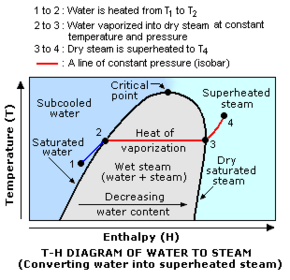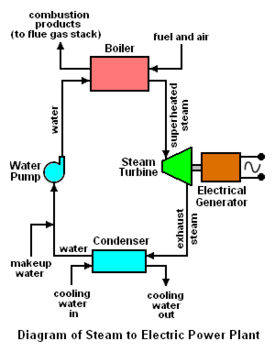User:Milton Beychok/Sandbox
Steam is the vapor (gaseous) phase of water (H2O). When the steam does not contain any liquid water, it is known as dry steam and it is completely colorless. However, when the steam contains tiny droplets of condensed liquid water, it appears to the eye as a white cloud (see the steam being vented from a geothermal power plant in the adjacent photograph).
What is very often referred to as smoke from cooling towers and other vents in industrial facilities is water vapor which has partially condensed and is mistaken to be white smoke.
Steam is manufactured in industrial processes by the boiling and vaporization of liquid water. It also occurs naturally by being vented from volcanoes, fumaroles, geysers and other geothermal sources.
Steam has a great many industrial and domestic uses. Probably the most important and by far the largest use of steam is in nuclear, fossil fuel and geothermal power plants .
Types of steam
As shown in the adjacent diagram, there are three types of steam:
- Wet steam: A mixture of water plus steam (liquid plus vapor) at the boiling point temperature of water at a given pressure.
- Dry steam: Steam, at the given pressure, that contains no water (also referred to as saturated steam).
- Superheatead steam: Dry steam, at the given pressure, that has been heated to a temperature higher than the boiling point of water at that pressure.
Referring to the adjacent drawing again, water is converted into wet, dry saturated or superheated steam in three steps:
- Water at point 1 is heated to its boiling point at the given pressure of point 2 (the dark blue line). At that point the water is then referred to as saturated water. The amount of heat added between between points 1 and 2 is called sensible heat.
- The water is further heated at constant pressure (the red isobar from point 2 to point 3) to form wet steam. When it is completely vaporized (at point 3), it is then dry saturated steam. The amount of heat required to completely vaporize the water is called the heat of vaporization and denoted as Hv or Hvap.
- The dry saturated steam is yet further heated at constant pressure (the red isobar from point 3 to point 4). The steam is then referred to as superheated steam. The amount of heat added to superheat the dry saturated steam is also called sensible heat.
Uses
Electricity generation
The worldwide capacity of electrical power generation by conventional coal-fired power plants currently amounts to about 800,000 MW[1][2][3][4] and the worldwide capacity of nuclear power generation amounts to about 370,000 MW.[5][6] That amounts to a total of 1,170,000 MW of worldwide generation, most of which involves the use of superheated steam to drive the turbines that spin the electrical generators (see the adjacent schematic diagram).[7]
Assuming an overall thermal efficiency of 34%, a steam generator (boiler) efficiency of 75 to 85% and an electrical generator efficiency of 98.5%, a conventional coal-fired power plant would use superheated steam at a rate of 3.47 to 3.93 (t/h) per MW of power output. Thus, a 1000 MW power plant would use 3,470 to 3,930 metric tons (tonnes) of steam per hour and the steam used by the 1,170,000 MW of worldwide power generation by coal-fired and nuclear power plants might be as much as 4,000,000 to 4,600,000 metric tons of steam per hour.
The adjacent diagram schematically depicts the equipment used in a conventional fuel-fired steam to electric power plant and which is referred to in thermodynamic terms as a Rankine cycle. A nuclear power plant differs only to the extent that the heat required by the boiler is provided by heat derived from a nuclear reactor.
Cogeneration
Cogeneration is also referred to as combined heat and power or CHP. In electrical power generation, the turbine exhaust steam is typically condensed and returned to the boiler for re-use. However, in one form of cogeneration, the all or part of the turbine exhaust steam is distributed through a district heating system to heat buildings rather than being condensed. The world's biggest steam cogeneration system is the district heating system which distributes steam from seven cogeneration plants to provide heating for 100,000 buildings in the city of New York.[8][9]
Steam engines
A steam engine uses the expansion of steam in order to drive a piston or turbine to perform mechanical work. The ability to return condensed steam as water-liquid to the boiler at high pressure with relatively little expenditure of pumping power is important. Engineers use an idealised thermodynamic cycle, the Rankine cycle, to model the behavior of steam engines.
Heat transfer in industrial process facilities
Other uses
- Sterilization
- An autoclave, which uses steam under pressure, is used in microbiology laboratories and similar environments for sterilization.
- Agricultural
- In agriculture steam is used for soil sterilization to avoid the use of harmful chemical agents and increase soil health.
- Domestic uses
- Steam's capacity to transfer heat is also used in the home: for cooking vegetables, steam cleaning of fabric and carpets, and heating buildings. In each case, water is heated in a boiler, and the steam carries the energy to a target object. "Steam showers" are actually low-temperature mist-generators, and do not actually use steam.
Steam tables and diagrams
Steam tables are tables of thermodynamic data for water/steam. They are often used by engineers and scientists in design and operation of equipment where thermodynamic cycles involving steam are used. Additionally, thermodynamic phase diagrams for water/steam, such as a temperature-entropy diagram or a Mollier diagram shown in this article, may be useful.
References
- ↑ A megawatt (MW) of electrical power is often denoted as MWe to differentiate it from other forms of power.
- ↑ International Energy Agency, 2006, Key Energy Statistics (International Energy Agency)
- ↑ International Energy Outlook 2008; Highlights (Energy Information Administration, U.S. DOE)
- ↑ International Energy Outlook 2008: Chapter 5 (Energy Information Administration, U.S. DOE)
- ↑ Energy, Electricity and Nuclear Power Estimates for the Period up to 2030 2009 Edition, International Atomic Energy Agency
- ↑ Nuclear Power Plants, Worldwide European Nuclear Society
- ↑ The amount would be even larger if power plants using other fuels were included (i.e., fuel oil, natural gas and biomass, wood, etc).
- ↑ Steam Carl Bevelhymer, Gotham Gazette, November 10, 2003
- ↑ Newsroom: Steam From the website of the Con Edison company in New York.


